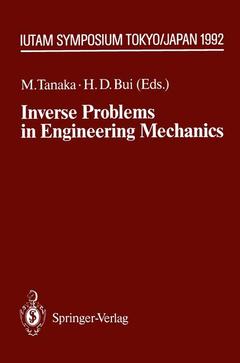Description
Inverse Problems in Engineering Mechanics, Softcover reprint of the original 1st ed. 1993
IUTAM Symposium Tokyo, 1992
Coll. IUTAM Symposia
Coordinators: Tanaka Masataka, Bui Huy D.
Language: French
Subject for Inverse Problems in Engineering Mechanics:
Publication date: 07-2012
564 p. · 15.5x23.5 cm · Paperback
564 p. · 15.5x23.5 cm · Paperback
Description
/li>Contents
/li>
Inverse problems occur in a wide variey of fields. In general, the inverse problem can be defined as one where one should estimate the cause from the result, while the direct problem is concerned with how to obtain the result from the cause. The aim of this symposium was to gather scientists and researchers in engineering mechanics concerned with inverse problems in order to exchange research result and develop computational and experimentalapproaches to solve inverse problems. The contributions in this volume cover the following subjects: mathematical and computational aspects of inverse problems, parameter or system identification, shape determination, sensitivity analysis, optimization, material property characterization, ultrasonic nondestructive testing, elastodynamic inverse problems, thermal inverse problems, and other miscellaneous engineering applications.
List of Contents.- 1 Mathematical Aspects.- On Regularization Methods within System Identification.- New Approaches to the Optimal Regularization.- A Method for Solving Inverse Boundary-Value Problems Using Symbolic Computation.- An Application of the Fuzzy Control for an Ill-posed Problem.- Inverse Filtering for Reverberant Transfer Functions.- 2 Computational Aspects.- Classification of Inverse Problems Arising in Field Problems and Their Treatments.- A Physically Based Method of Experimental Data-Concepts, Formulation and Application to Identification of Residual Stresses.- Inverse Problems for Vibrating Systems in Two and Three Dimensions.- Inverse Spectrum Problems for Block Jacobi Matrix.- Parametric Correction of Finite Element Models Using Modal Tests.- Structural Defect Synthesis Using Noise-Frequency Response Characteristics for Coupled Acoustic-Structural System by Fuzzy Inference Method.- Inverse Problem Solution in Non-destructive Pavement Diagnostics -Computational Aspects.- Inverse Formulation for Incompressible Viscous Two-Dimensional and Axisymmetric Flow Problems.- 3 Parameter Identification.- Requirements for the Structure of Analytical Models Used for Parameter Identification.- Inverse Problem in Mechanics of Structures: a New Approach Based on Displacement Field Processing.- New Method for Determining Contact Pressure Disributions by Using Caustic Images.- Estimation of Impact Force by an Inverse Analysis.- Optimality of Internal Structure and Identification of Unknown Load.- 4 Shape Determination and Optimization.- Shape Identification Using Acoustic Measurements: A Numerical Investigation Using BIE and Shape Differentiation.- Shape Determination of a Scattering Obstacles by Eigenfunction Expansion Embedding Integral Method.- Indentification of Crack Shape Hidden in Solid by Means of Neural Network and Computational Mechanics.- Approximate Recovery and Redesign of a Curved Surface Based on a Flattened Form.- Optimum Design of a Sound-Insulating Wall by the Boundary Element Method.- Optimal Design of Cooling Lines of Injection Mold Based on Boundary Element Design Sensitivity Analysis.- Efficient Shape Optimization Technique Based on Boundary Element Method.- 5 Material Property Characterization.- Inversion of Surface Acoustic Wave Data to Determine the Elastic Constants of Nitride Films.- Inversion of Source, Material, and Defect Characteristics Using Guided Waves.- Inverse Problems Associated with Nondestructive Evaluation of Plasic Damages in Solids.- Identification Aspects of Inhomogeneous Materials.- A Parameter Identification Procedure as a Dual Boundary Control Concept for Wave-Propagation Problem.- Identification of Dynamic in Situ Soil Properties at Existing Structure Site.- Characterization of the Damping Effect of a Vibrating System.- Identification of Parameters in Geomechanics Using a Maximum Likelihood Approach.- Identification Analysis of Distributed-Parameter Systems by Using Kalman Filter-Boundary Element Method.- 6 Elastodynamic Inverse Problems.- Inverse Scattering for Flaw Type Classification.- Shape Inversion from Phase Shifts.- Determination of Shapes, Sizes and Material Compositions of Large Inclusions in Elastic Media from Scattered Waves.- Estimation of Unknown Boundary Values by Inverse Analysis with Elastodynamic Boundary Element Method.- Source Inversion of High-Frequency Strong Motion Records in the Near-Source Region.- Optimum Strong-Motion Station-Array Geometry for Earthquake Source Studies.- 7 Ultrasonic Nondestructive Evaluation.- Neural Network Approach to the Inverse Problem ofCrack- Depth Determination from Ultrasonic Backscattering Data.- Simulation of Directivity Synthesis for Ultrasonic Transducers.- Inversion Using Multi-Tip Echoes of Elastic Waves.- Surface Reconstruction of a Three-Dimensional Ultrasonic Flaw.- Generalized Ray Theory and Its Application to Long-Distance Ultrasonic Testing.- A New Approach to Ultrasonic Image Reconstruction.- 8 Thermal Inverse Problems.- Identification of Heat Conduction Coefficient: Application to Nondestructive Testing.- Determination of Void Shapes, Sizes, Numbers and Locations Inside an Object with Known Surface Temperatures and Heat Fluxes.- Determination of Time Dependence of Temperature in the Inner Surface of a Cylinder by Measured Informations on the Outer Surface.- Transfer Function Approach for Solving Inverse Heat Conduction Problems in Piping Using Experimental Data.- A Method for Disbond Detection in Thermal Tomography by Domain Decomposition Method.- 9 Other Engineering Applications.- Inverse Problem Approach Based on the Kalman Filtering and Its Applications.- The Thin Shell Approach for Some 3D Engineering Inverse Problems.- Inverse Analysis for Estimating Galvanic Corrosion Rate.- Estimation of an Electric Orbit Using Super-Potentials of Lienard-Wiechert Potentials.
© 2024 LAVOISIER S.A.S.




